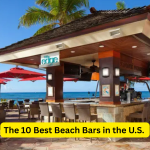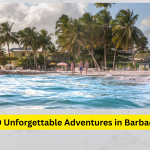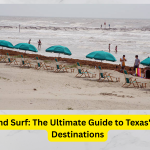Walking on Fire: 10 Black-Sand Beaches You Won’t Believe Are Real
Imagine stepping onto a shoreline as black as charcoal, volcanic sand crunching underfoot. These surreal beaches – born of fiery lava and icy ocean – feel like scenes from another world.
We’ve rounded up 10 breathtaking black-sand beaches, each with a wild backstory and Insta-worthy views. Dive into this list and discover where adventure meets the extraordinary!
1. Reynisfjara Beach, Iceland

Why It’s Famous
Reynisfjara is arguably the most famous black sand beach in the world. Its striking black pebbles, roaring Atlantic waves, and towering basalt columns make it a geological marvel.
- Basalt columns formed from rapidly cooling lava
- Reynisdrangar sea stacks, which local legend says are trolls turned to stone
- Dangerous waves, often with powerful “sneaker waves” that can reach far inland
Pop Culture Note:
Featured in shows like Game of Thrones and movies such as Rogue One: A Star Wars Story.
Travel Tip:
Stay behind warning signs and never turn your back on the waves. The beach is beautiful but can be hazardous.
2. Punaluʻu Beach, Hawaii, USA

What Makes It Unique
Punaluʻu Beach is Hawaii’s most iconic black sand beach, created by lava flowing into the sea and breaking apart.
- Nesting ground for endangered green sea turtles (honu)
- Home to hawksbill turtles, another protected species
- Surrounded by lush vegetation and coconut palms
Best Activities:
Turtle watching (from a distance), picnicking in shaded areas, exploring nearby tide pools.
Important Note:
Do not touch or disturb the turtles. It’s both illegal and harmful to the animals.
Black Sand Beaches FAQ (Part 1)
The black color comes from volcanic minerals, primarily basalt, which is created when lava cools rapidly upon contact with ocean water. The lava shatters into tiny fragments that eventually become fine black sand.
Yes! Black sand absorbs more sunlight than white sand, making it significantly hotter to walk on during sunny days. Always wear appropriate footwear to protect your feet.
In most cases, no. Many locations prohibit removing sand or rocks from black sand beaches, both for environmental protection and cultural reasons (some consider it bad luck). Always check local regulations.
3. Kamari Beach, Santorini, Greece

Volcanic Origins
Kamari’s striking dark sands are remnants of the massive Minoan volcanic eruption that shaped Santorini’s caldera thousands of years ago.
- Long stretch of fine black pebbles
- Calm, clear Aegean waters
- Views of Mesa Vouno Mountain
Ideal For:
Swimming and snorkeling, sunbathing with amenities like sunbeds and umbrellas, dining at seafront tavernas.
4. Lovina Beach, Bali, Indonesia

Tranquility and Dolphins
Lovina Beach offers a peaceful contrast to the bustling south of Bali. Its black sand shores are ideal for relaxation and early morning dolphin-watching tours.
- Calm waters suitable for families
- Coral reefs just offshore for snorkeling
- Traditional fishing villages nearby
Best Time to Visit:
Sunrise to catch dolphins leaping over calm seas against a backdrop of glowing skies.
Black Sand Beaches FAQ (Part 2)
It depends on the beach. Some like Kamari in Greece have calm waters perfect for swimming, while others like Reynisfjara in Iceland have dangerous currents. Always check local conditions and warnings.
Not necessarily. The formation depends on the type of volcanic rock and ocean currents. Some volcanic islands have white sand from coral or other minerals, while others have a mix of both.
The texture depends on how the lava cooled and how long it’s been eroded by waves. Younger beaches tend to be more pebbly, while older ones have finer sand from prolonged wave action.
Mediterranean or Tropical Black Sands?
Would you rather visit Greek island charm of Kamari or the dolphin-filled waters of Bali’s Lovina Beach? Let us know your pick!
5. Batu Hitam, Malaysia

Name Meaning
“Batu Hitam” means “Black Stones” in Malay. This beach is known for its combination of dark stones and pale sand, creating a unique contrast.
- Popular with locals for weekend picnics
- Less touristy than other Southeast Asian beaches
- Ideal for coastal photography
6. Tithal Beach, Gujarat, India

Spiritual Meets Scenic
One of India’s few black sand beaches, Tithal is known for its clean coastlines and proximity to religious landmarks.
- Nearby Swaminarayan and Sai Baba temples
- Hosts Tithal Beach Festival with cultural performances
- Offers camel rides and beach sports
Ideal For:
Spiritual travelers and families, local street food lovers, casual beach photography.
Black Sand Beaches FAQ (Part 3)
Generally yes, but with precautions. The sand can get extremely hot, so bring appropriate footwear. Also be mindful of stronger waves at some volcanic beaches compared to typical sandy beaches.
All genuine black sand beaches are natural formations from volcanic activity. Some resorts may import black sand for aesthetic purposes, but these aren’t considered true black sand beaches.
Some contain magnetite, an iron oxide mineral that’s naturally magnetic. This gives the sand unique properties and sometimes creates sparkles in sunlight.
Cultural or Natural Wonders?
Would you rather visit Malaysia’s Batu Hitam for its natural beauty or India’s Tithal Beach for its cultural significance? Share your preference below!
7. Miho no Matsubara, Japan

Mt. Fuji’s Dark Mirror
This black sand beach lined with over 30,000 pine trees offers incredible views of Mt. Fuji across Suruga Bay.
- Recognized as a UNESCO World Heritage Site
- Celebrated in Japanese poetry and artwork
- Offers walking paths and tranquil viewing spots
Best Time to Visit:
Clear winter days when Mt. Fuji is most visible against the dark sand contrast.
8. Karekare Beach, New Zealand

Wild Beauty
Known for its raw, untamed beauty, Karekare Beach is famous for its dark, iron-rich sand dunes and dramatic cliffs.
- Featured in the Oscar-winning film The Piano
- Less crowded than neighboring Piha Beach
- Great for hiking to nearby waterfalls
Note:
Strong rip currents make swimming dangerous here – best enjoyed for scenic walks and photography.
Black Sand Beaches FAQ (Part 4)
Some do. Unlike white sand that’s continually replenished by coral, black sand beaches can erode without new volcanic material. Some famous black sand beaches have significantly diminished due to storms and mining.
Yes! Besides Hawaii’s Punaluʻu, you can find black sand beaches in Alaska (like Katmai National Park) and some Pacific Northwest beaches have dark sand mixes from volcanic minerals.
The additional colors come from other volcanic minerals like olivine (green) or iron oxide (red) mixed with the basalt. These colorful variations make some beaches even more unique.
Cinematic or Serene?
Would you rather visit New Zealand’s dramatic Karekare (famous from The Piano) or Japan’s peaceful Miho no Matsubara? Tell us which appeals to you more!
9. Playa Negra, Costa Rica

Tropical Paradise With a Dark Twist
Playa Negra is a surfer’s paradise with powerful waves and soft black sand, offering a unique Caribbean experience.
- Consistent surf breaks for all skill levels
- Laid-back beach town vibes
- Scenic sunsets with palm silhouettes
Surf Tip:
The northern end has gentler waves for beginners, while the southern breaks challenge experienced surfers.
10. Spiaggia di Maratea, Italy

Underrated Gem
This lesser-known beach along the Tyrrhenian Sea is framed by cliffs and caves, offering a peaceful Mediterranean escape.
- Great for snorkeling and diving
- Crystal-clear waters and natural grottos
- Authentic Italian coastal charm
Local Secret:
Visit the nearby Grotta della Sciabella cave at low tide for an unforgettable swim through illuminated waters.
Black Sand Beaches FAQ (Final Part)
Yes! Besides Iceland and Italy’s Spiaggia di Maratea, you can find black sand beaches in Greece (Santorini), the Canary Islands (Spain), the Azores (Portugal), and some beaches in France’s Réunion Island.
The volcanic topography often creates steep underwater drop-offs near shore, causing powerful waves and strong currents. Always heed local warnings – these beaches can be more hazardous than typical sandy beaches.
Some Caribbean and Mediterranean cruises stop near black sand beaches (like Santorini). However, many spectacular black sand beaches require independent travel as they’re not near major ports.
Which Black Sand Beach Is Now On Your Bucket List?
After seeing these incredible destinations, which one are you most excited to visit? Share your thoughts and travel plans with our community!



Which of these first two beaches intrigues you more?
Would you rather visit Iceland’s dramatic Reynisfjara or Hawaii’s turtle-filled Punaluʻu? Share your thoughts below!